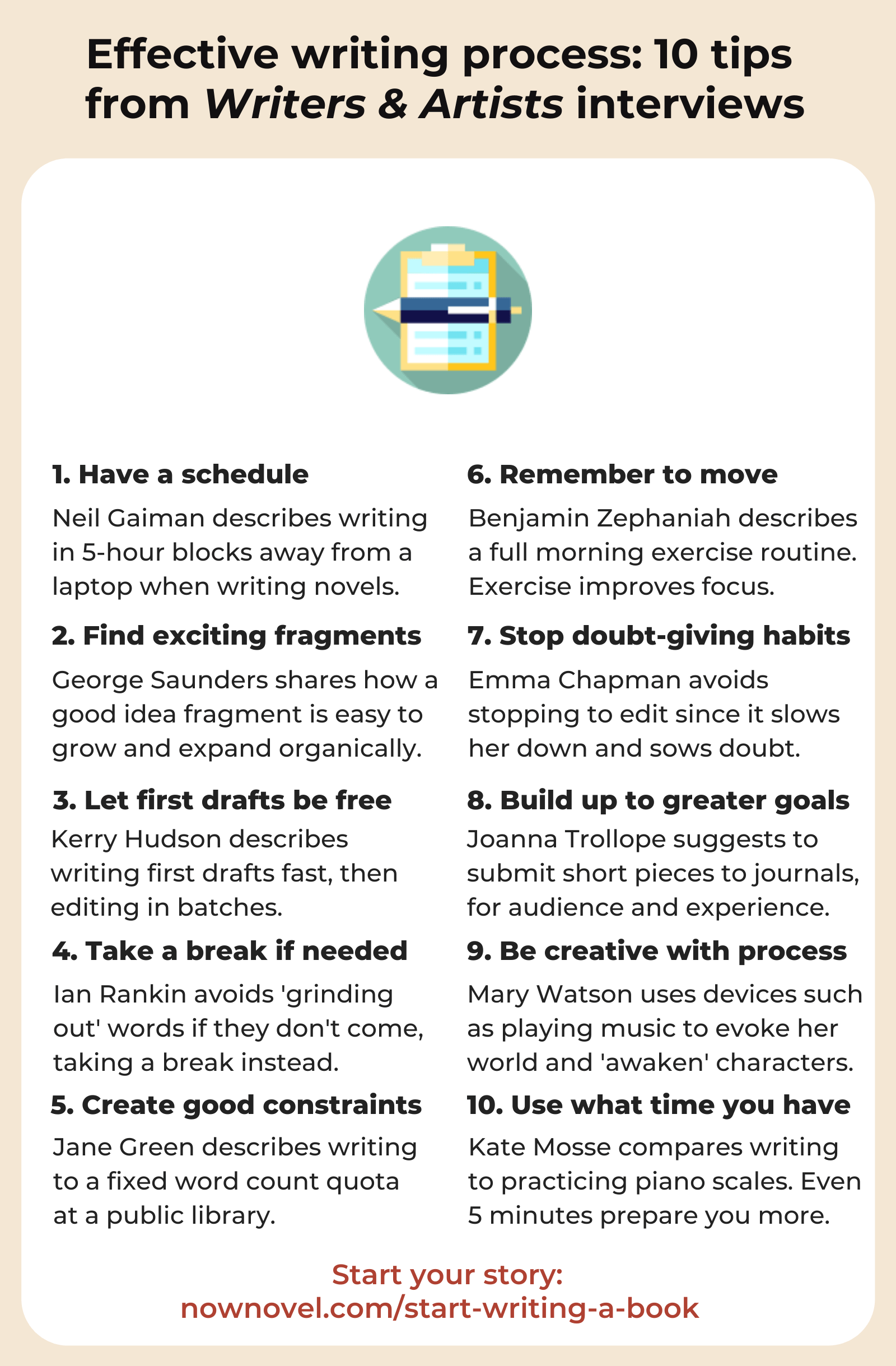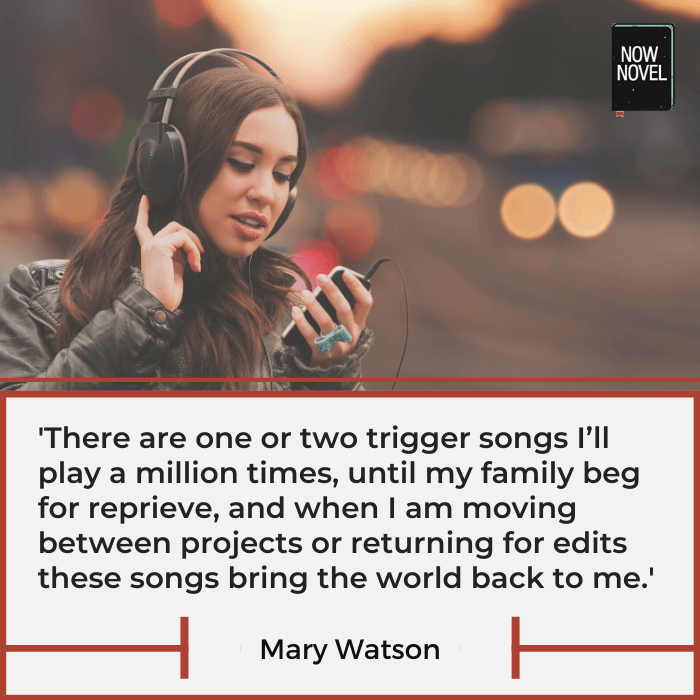The writing process is something every author finds a way to navigate. Writers & Artists: The Insider Guide to the Media regularly interviews authors about their process. Read tips from 10 established authors’ writing routines and approaches:
1. Have a schedule
There’s truth to the saying ‘a goal without a plan is just a wish’.
Blocking off time is essential when you’re getting further into a writing project. Neil Gaiman describes his general schedule when writing a novel:
If I’m writing a novel, I’ll probably get up in the morning, do email, perhaps blog, deal with emergencies, and then be off novel-writing around 1.00pm and stop around 6.00pm. And I’ll be writing in longhand, a safe distance from my computer.
Neil Gaiman, in ‘Interview with Neil Gaiman’, available here.
The practicality here is simple. Treat writing like a regular job (even if it’s a job for which you have one hour for per day, and not five). As Gaiman says, ‘even a hundred bad words that didn’t exist before is forward progress.’
2. Find exciting fragments
Often, there’s great story potential in the smallest fragment: An image, idea, sentence or concept.
Author George Saunders shares, for example, how he was walking behind two girls in the mall and heard the one swear and her friend reply ‘I know’, and how this inspired his story ‘Sea Oak’.
Further on, Saunders describes the importance of finding ideas with potential for expansion:
You start with the smallest little thing and then by reworking it, it will grow outward very organically. You don’t have to worry too much about ideas at the beginning, but you have to find some little fragment that excites you for a reason that you can’t explain.
George Saunders, in ‘A Quick Word With George Saunders’, available here.
[Brainstorm your next great idea in easy steps in the ‘Central Idea’ section of our outlining tool.]
3. Let first drafts be free
Author Kerry Hudson describes writing a fast first draft. She then edits in batches: a useful way to stay productive:
First draft, I write that very fast and then I go back and try to edit maybe 10/15 pages a day, as I do my revisions. And that, having those small chunks of time where you’re really really focused, has been the only way I’ve found I can be productive!
Kerry Hudson, in ‘Kerry Hudson on Voice’, available here.
Even if you don’t write a fast first draft, leave the tinkering for once you have something more substantial to work on.

4. Take a break if needed
Crime author Ian Rankin describes how he does not have a ‘typical’ work day, but will write 5 days a week when in the thick of a novel.
Rankin also describes the importance of recognizing when to take a break:
When I’m working on a book, I tend to work five-day weeks, writing late into the night. But if the day isn’t going well, I will walk away and do something else, rather than force myself to grind out the words and scenes.
Ian Rankin, in ‘Interview with Ian Rankin’, available here.
Rather than place undue pressure on yourself, schedule in breaks. Coming back to a story with fresh eyes is a great way to stay focused and intentional.
5. Create good constraints
Having in place constraints that force you to write, and reach your targets, is useful.
Novelist Jane Green describes how writing at the public library to a pre-chosen word count keeps her on track:
When I am writing, I have to force myself to leave the house and be at the local public library by around 9am. I take my laptop, grab a coffee en route, and sit in a quiet room at a cubby until my quota of words is on the page.
Jane Green in ‘Interview with Jane Green’, available here.
Is there a place you can write with less distraction? Find the circumstances that make it easiest for you to remain focused.
6. Remember to move
The writing process also consists of the things we do to feed our energy, focus, ideas and mood.
Novelist and poet Benjamin Zephaniah describes a morning routine that involves plenty of movement:
If I’m in England and on Greenwich Mean Time, I get up about 7am. I always start my day with a run or a cycle ride, then I come home to my gym and do a boxing and Kung Fu work out. When I have pushed myself to the limit I slow down with some Yoga and Tai Chi. I then have breakfast. I check my emails, post, and reply to those that need attention. Then I start working.
Benjamin Zephaniah, in ‘Interview with Benjamin Zephaniah, available here.
You may not have this much time to devote to exercise. Even a 15-minute walk or jog is something. It will get the blood flowing and help you relax and lean into the intense focus writing demands.

7. Stop doubt-giving habits
It’s often tempting to edit 500 words over and over instead of progressing further.
Author Emma Chapman shares the benefits of working smart and keeping sessions shorter:
I work focused and uninterrupted until I’ve written about 1500-2000 words. I try not to look back and get tempted into editing– I find this slows me down and makes me doubt. I trust my subconscious. I spend the rest of the day guilt-free, working on marketing How To Be A Good Wife, blogging, or reading other things. It’s quite ironic really, because when I was writing How To Be A Good Wife, I was working full time and would work for about an hour every morning before work. I have returned to that routine now, as I found having unlimited time to write was actually hindering my process.
Emma Chapman, in ‘Interview with Emma Chapman’, available here.
8. Build up to greater goals
The writing process is a gradual development of both storytelling skill and awareness of your own writing process – what works for you.
Joanna Trollope compares writing to an apprenticeship, advising:
Like all creative arts, writing needs an apprenticeship, and it is a good idea to work up slowly rather than to think one can go from a standing start to flying without any of the intermediary processes! So look around for local magazines and publications one might contribute to, and begin sending them samples – and an audience and a public profile will grow.
Joanna Trollope, in ‘Interview with Joanna Trollope’, available here.
Many famous novels – James Joyce’s A Portrait of the Artist as a Young Man among them – started as short stories. It helps to start with shorter versions of stories or practice runs. This enables you to work out the shape of the story and expand on what you have further as you wish.
9. Be creative with the writing process
Some writers say they can write anywhere. Others find an element of ritual or preparation helpful in ‘awakening’ characters for the task. Mary Watson describes this latter approach, and the role music plays in her process:
I use scented candles and music (game soundtracks are my favourite) as sensory triggers to help me shift mental space from the school run and doing the dishes to a small village where magic is real. With each book there are one or two trigger songs I’ll play a million times, until my family beg for reprieve, and when I am moving between projects or returning for edits these songs bring the world back to me. It’s so Pavlovian now that when I hear these songs, the characters wake up.
Mary Watson, in ‘An interview with Mary Watson’, available here.
10. Use what time you have
It’s easy to feel discouraged if you only have 10 minutes a day to write. But any time spent practicing craft, finding the sentences that make a story, helps. Author Kate Mosse says:
[My advice is to] write! Five minutes of writing a day is better than no minutes. Too many new writers think that unless they have plenty of time, it’s not worth booting up the computer or sharpening that pencil. But think of it, instead, like practising scales on the piano before tackling that Beethoven Concerto or like warming-up in the gym – the more you prepare for writing, the better shape you’ll be in once you have time to really concentrate.
Kate Mosse, in ‘Interview with Kate Mosse’, available here.
What’s helped you build a writing process that works for you? Share your thoughts below.
Join Now Novel for an easy, step-by-step outlining process and extra support when you get a writing coach.


2 replies on “The writing process: 10 tips from Writers & Artists”
After reading this post, I think I need to to work on number 5, at least for a starter. Where I sit now to write is just too noisy and disrupted. I want to blame my poor writing sessions of external forces where I sit. Yet, I could move to a more isolated place and, also, adjust my writing schedule.
Hi Glynis, that sounds like a great plan 🙂 a change of writing environment is always worth a try. Thanks for reading and sharing your thoughts.